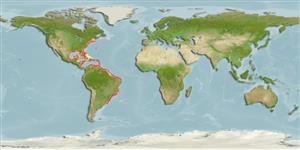Common names from other countries
Environment: milieu / climate zone / depth range / distribution range
Ecologia
marinhas demersal; intervalo de profundidade 50 - 500 m (Ref. 26999), usually 100 - 200 m (Ref. 26999). Subtropical; 45°N - 35°S, 98°W - 34°W
Western Atlantic: Canada (Ref. 5951) to Maine, USA and northern Gulf of Mexico to Uruguay. Eastern Atlantic: Senegal to Angola (Ref. 5512).
Comprimento de primeira maturação / Tamanho / Peso / Idade
Maturity: Lm 10.0 range ? - ? cm
Max length : 30.0 cm TL macho/indeterminado; (Ref. 7251); common length : 23.0 cm FL macho/indeterminado; (Ref. 47377)
Espinhos dorsais (total) : 12; Raios dorsais (total) : 13 - 16; Espinhos anais: 3; Raios anais : 15.
Occurs chiefly on the continental shelf, mostly on muddy bottoms (Ref. 2683). Juveniles occur in surface waters. Feeds mainly on small crustaceans. Forms large schools (Ref. 36543). Adults are demersal or bathypelagic (Ref. 47377).
Ciclo de vida ou comportamento de acasalamento
Maturities | Reprodução | Spawnings | Egg(s) | Fecundities | Larvas
Oviparous, gonochorous, with pelagic eggs (Ref. 101194).
Robins, C.R. and G.C. Ray, 1986. A field guide to Atlantic coast fishes of North America. Houghton Mifflin Company, Boston, U.S.A. 354 p. (Ref. 7251)
Status na Lista Vermelha da UICN (Ref. 130435)
CITES (Ref. 128078)
Not Evaluated
Ameaça para os humanos
Harmless
Uso pelos humanos
Pescarias: pouco comercial
Ferramentas
Relatórios especiais
Baixar XML
Fontes da internet
Estimates based on models
Preferred temperature (Ref.
115969): 13 - 23.8, mean 19 (based on 119 cells).
Índice de diversidade filogenética (Ref.
82804): PD
50 = 0.5156 [Uniqueness, from 0.5 = low to 2.0 = high].
Bayesian length-weight: a=0.01479 (0.00917 - 0.02386), b=2.93 (2.79 - 3.07), in cm Total Length, based on LWR estimates for this species & (Sub)family-body (Ref.
93245).
Nível Trófico (Ref.
69278): 3.5 ±0.50 se; based on food items.
Resiliência (Ref.
120179): Elevada, tempo mínimo de duplicação da população menor que 15 meses (Preliminary K or Fecundity.).
Fishing Vulnerability (Ref.
59153): Low vulnerability (20 of 100).
